Estrous
cycle control in the cow
 290-294 290-294
Goal

- The goal in controlling the bovine estrous
cycle it to have all the cows in heat at exactly the same time so
heat detection can be eliminated entirely. Synchronizing estrus is a
method to condense heat detection and breeding efforts into a
tighter time frame. This tighter time frame allows the dairy
producer to concentrate efforts more efficiently on breeding and
allows easier use of artificial insemination in beef herds.
- It is also a good management tool for the 5% of
beef cows that have AI. Estrous synchronization allows easier AI
because of the decreased heat detection needed. This allows beef
producers to use better bulls and attain a more uniform calf crop
with higher weaning weights, and earlier puberty in the calves.
- In dairy cows heat detection is almost always
the number 1 ranked problem. Estrous synchronization decreases heat
detection and can make life easier on a dairy.
- Presently, estrous synchronization is only
successful at grouping cows into estrus, not getting all of them
into estrus at exactly the same time.
Problems
- None of the methods are fertility drugs. The AI
technique must be good and usual heat detection ability must be good
for the system to succeed. Animal handling facilities must also be
good. If 100 cows are in heat and the first one breaks open the gate
and allows the other 99 to get loose, then it really does not matter
that they are all in heat at once, because you cannot catch them to
breed them.
- In all situations the cows must be cycling for
the system to work. Anestrus cows will not respond to these
protocols, the cows must be cycling.

Products

- There are two basic methods to synchronize
estrus. One is to kill the corpus luteum that is present with
exogenous prostaglandin so the cow comes into heat. The other is to
create an artificial luteal period with progestagens, then abruptly
remove the progestagen and allow the cow to come into heat.
- Prostaglandins 'kill' the corpus luteum and allow a follicle to
grow
- Progestagens create an artificial luteal period.
- In beef cows and dairy heifers entire groups or
herds are usually synchronized at one time and both progestagens and
luteolytic drugs can be used. However, in lactating dairy cows a
limited number of cows in a week's time are eligible for estrous
synchronization and only prostaglandin products are approved for
use.
Prostaglandins
Products
- The products generally available are 'Lutalyse'
which is the natural PGF (tham salt: dinoprost tromethamine). The
dose is 25 mg or 5 cc IM.
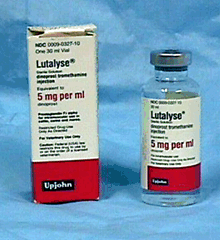
- 'Estrumate' is the prostaglandin analogue
cloprostenol. The dose is 500 mcg or 2 cc IM.
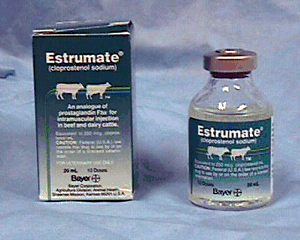
- Bovilene is the prostaglandin analogue
fenprostalene. The dose is 2 cc SQ. This is a longer acting product
and was first approved as an abortifacient.
Method of action
- These exogenous prostaglandins have the same
pharmacological action as the endogenous prostaglandin released
during the estrous cycle. The prostaglandin binds to receptors on
the mature corpus luteum and basically kills the corpus luteum. As
progesterone falls, follicles grow and the cow comes into heat.
When will cows respond to prostaglandin?
- Anytime a mature corpus luteum is present
prostaglandin will lyse it and allow the cow to come into heat.
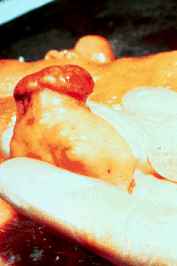
- The best estrual response is normally seen when
the drug is given after day 8 of the cycle.
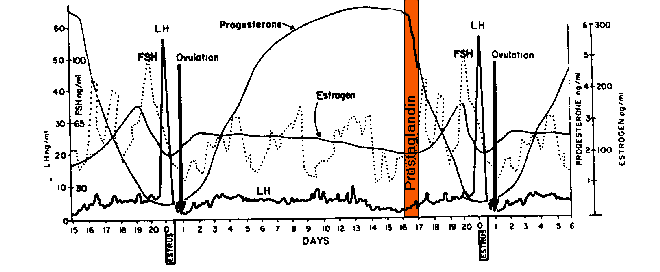
This chart shows the normal prostaglandin surge in a non-pregnant
cow.
- Any dominant follicle can potentially ovulate
if the exogenous prostaglandin is luteolytic. However, once a
dominant follicle has become static for 2 days or is regressing, a
new follicle must be recruited that will ovulate if the corpus
luteum is lysed. This varying dominant follicular response, not the
time to luteal regression, leads to the variability in estrual
response after prostaglandin administration.
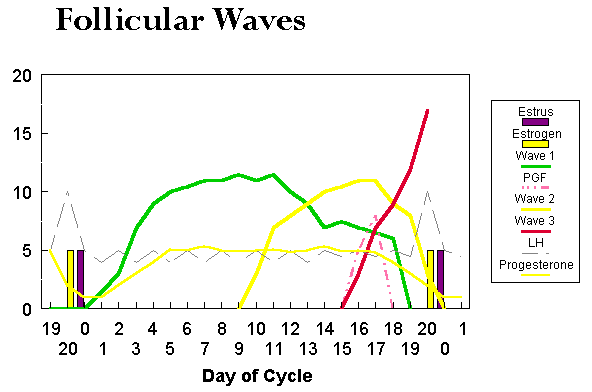
This chart shows the follicular waves in a '3
wave' cow.
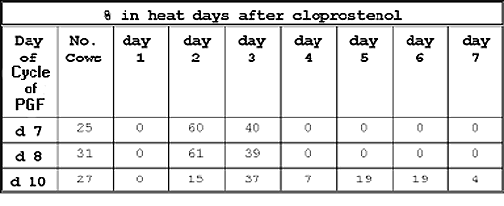
This chart shows the estrual response after
prostaglandin on 7, 8, or 10 of the cycle.
On day 8 the synchrony is tight is because the
dominant follicle can respond.
On day 10, just 2 days later, the dominant
follicle cannot respond, so the synchrony is not tight.
 Prostaglandins
in dairy cows Prostaglandins
in dairy cows

Click to see
PowerPoint on Prostaglandin Synchronization Schemes

- The usual method on a dairy is to wait until
the voluntary waiting period is over and then assign cows to groups
to receive a PGF injection, for example on a Monday. Estrus
detection is then limited to the next 4 days.
Single Injection Prostaglandin Injection System
|
Day
of Cycle
|
Response
to PGF
injection
|
|
0 -
6
|
7/21 Will
not respond
|
|
7
|
May or May
not respond
|
|
8
-16
|
9/21
should respond and be in heat in 1-5 days,
BREED !!
|
|
17-20
|
4/21
Will not respond, but will be in heat in
1-4 days, BREED !!
|
- As can be seen from the figure above, in a
group of randomly cycling animals only 13/21 should come into estrus
and only 9/21 actually respond to the PGF meaning 'wasting' 12 doses
out of 21.
- To minimize this problem, some practitioners will palpate
for the presence of a corpus luteum or have the producer run a milk
progesterone to determine if a corpus luteum is present.
- If we look
at the sensitivity and specificity of either of these tests, we find
that they are probably not cost beneficial. The cost of the mistakes
outweighs the cost of palpation.
- For example, looking at the figure
and using a sensitivity of 83% and a specificity of 53% for rectal
palpation identification of a corpus luteum (both figures are what
good palpators can achieve) we see that in a random cycling herd of
21 cows, 10 would have corpora lutea and 11 would not.
- Palpation
would say that 13 have a corpus luteum and 8 do not. Two cows that
should get PGF would not and 5 cows that do not have corpora lutea
would get prostaglandin. Instead of costing $63 for injections of
prostaglandins to all cows and having 10/21 respond, it would cost
at least $42 to palpate the cows, $26 for prostaglandin and only
8/11 would respond to PGF. Milk progesterone tests do not fare much
better for success.
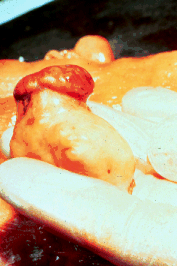 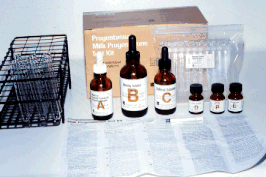
Sensitivity and Specificity of Rectal Palpation to
Determine the Presence of a
Mature Corpus Luteum in Cycling Cows
|
|
Corpus Luteum Present
|
|
|
Palpate
Corpus Luteum
|
Yes
|
No
|
Totals
|
|
Yes
|
8
|
5
|
13
|
|
No
|
2
|
6
|
8
|
|
Totals
|
10
|
11
|
21
|
- The tightness of the synchrony of those cows
responding to PGF will also not be very good because of the
different stages of dominant follicular growth. Some cows will come
into estrus soon, because a dominant follicle is ready to ovulate.
Some cows will not come into estrus until later because the dominant
follicle is regressing and a new follicle will take longer to grow
and ovulate. Whether to breed at estrus or to time breed is another
question. Since only about 14/21 cows will come into estrus, time
breeding will obviously not yield more than about a 30% conception
rate at best and 7 doses of semen will be totally wasted. Since the
synchrony is not very good in this system, conception will probably
be even lower than 30%. A cost analysis of time breeding in dairies
after PGF showed that (assuming PGF costs $6/dose and fixed heat
detection was 50% , or 60% when using PG) you should detect heat if
semen is >$5/straw. If heat detection is < 40% and if semen is
>$30/straw you should recommend heat checking. It was emphasized
that it is important that the use of PGF is done early and not
postponed for only 'problem' cows. No other methods are widely
accepted or used in dairy cows at present.
Prostaglandins in beef cows

- If beef cows are cycling, several options exist
on using prostaglandins to synchronize estrus. The traditional
technique described by the drug companies is to give an initial
injection of prostaglandin on day 0 and a second injection 11 days
later.
- Theoretically this allows all the cows on day
11 to have a corpus luteum that will respond to the second PGF
injection. If the animals are cycling, heat detection can be limited
to 5 days and estrual response is somewhat less variable than after
only 1 injection. In theory you 'waste' 11 (32) doses, which makes
the system rather cost intensive for prostaglandin. The decreased
variability to estrus can be explained by the fact that most of the
cows on day 11 are on about day 8 of their estrous cycle. On day 8
most cows have a growing dominant follicle that can ovulate after
luteolysis. In contrast, the totally random cycling herd has cows
that will respond to PGF but may not have a dominant follicle that
can ovulate, so a new follicle will have to grow over a variable
time frame in order to ovulate.
Double Injection Prostaglandin Injection
System
|
1st
injection
Day 0
|
|
2nd
injection
Day 11
|
|
|
Day of
Cycle Day 0
|
|
Day of
Cycle Day 11
|
|
|
0-6
|
7/21 Will
not respond
|
11-17
|
Should
respond and be in heat in 1-5 days,BREED !!
|
|
7
|
May or may not respond
|
8 or 18
|
|
|
8 -16
|
9/21 should respond and be
in heat in heat in 1-5 days
|
8
|
|
|
17 -20
|
4/21 Will not respond but
will be in heat in 1-4
days.
|
8
|
|
After the first PGF injection you heat check
and breed all those cows that come into estrus. After 11 days a
second PGF injection is given to those cows that were not bred. This
results in 'wasting' only 12 doses, but heat checking is increased
from 5 days to 10 days. This results in more labor cost, but less
drug cost.
Variation of the 2 injection system.
Double Injection Prostaglandin Injection
System With Breeding After
First Injection
|
1st
injection
Day 0
|
|
2nd
injection
Day 11
|
|
|
Day of
Cycle Day 0
|
|
Day of
Cycle Day 11
|
|
|
0-6
|
7/21 Will
not respond
|
11
|
Should
respond and be in heat in 1-5 days,BREED !! |
|
7
|
May or may
not respond
|
8 or 18
|
Breed or
Give second in injection. |
|
8 -16
|
9/21
should respond and be in heat in heat in 1-5 days,
BREED !!!
|
|
|
17 -20 |
4/21 Will not respond but will be in heat in 1-4 days, BREED
!!
|
|
- A good alternative to each of these systems is
to heat check the cows for 7 days and breed all those cows that come
into heat.
Single Prostaglandin Injection System Preceded by
7 Days of Heat Detection
|
Heat
Check, Breed 7
days
|
|
Injection
Day 7
|
|
|
Day of
Cycle Day 0
|
|
Day of
Cycle Day 7
|
|
|
0 -13
|
14/21 Will
not be in heat
|
7 -16
|
Should
respond and be in heat
in 1-5 days, BREED !!
|
|
14 -20
|
In heat
and BRED over the 7 day heat detection period.
|
|
|
- After 7 days of heat detection and breeding, a
dose of PGF is given to each cow that has not been bred. This means
that there are only 4 'wasted' PGF doses. It does mean that heat
detection is increased to 12 days. Some nice benefits of this system
are that it gets heat checking and breeding geared up. Since only a
few cows per day are being bred, there is no big push all at once.
It also is a good check to see if the cows are cycling and/or the
heat checking ability is good. If 5% of the cows are not seen in
heat every day, the cows are not cycling or the heat detection
ability is not good.
Progestagens in
beef cows

- Exogenous progestagens create an artificial
luteal period that prevents the cow from coming into estrus. The
early use of long term progestagens (>14 days) such as
medroxyprogesterone acetate (MAP), chlormadionone acetate (CAP), and
melengestrol acetate (MGA) were very effective at preventing estrus
and resulted in a large percentage of cows coming into estrus after
withdrawal, but pregnancy rates were very low. The result was that
the products were not really very effective.
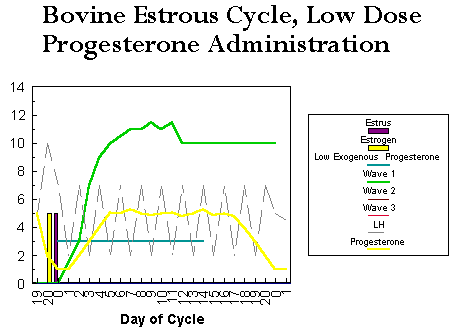
Low dose progestagen allows an aged wave 1
follicle to ovulate upon progestagen withdrawal.
- Shorter term treatments with progestagens
combined with luteolytic drugs resulted in good synchrony and better
conception rates.
SYNCRO-MATE B
- As of August 1999, this product is not
available in the United States because of production difficulties in
obtaining some of the raw materials from overseas.
- The most popular treatment is SYNCRO-MATE B (SMB)
which combines a 5 mg estradiol valerate + 3 mg norgestomet
injection with a norgestomet (6 mg) ear implant that is removed
after 9 days.
- Results reported by the company look very good
for SMB, but in other trials fertility is less than ideal. The
fertility in these in these other trials depended upon the days of
estrus that the treatment started.
- If the treatments started late in the estrous
cycle, conception was lower. Inspection of those cows with lower
conception rates revealed that upon treatment, a dominant follicle
was present. This dominant follicle persisted, aged, and ovulated an
old oocyte when the progestagen was withdrawn. Persistence of the
follicle was allowed by the lower doses of progestagens not
preventing the LH release. With normal LH release, new follicular
waves are prevented from arising.
- Availiable as
CRESTAR in Europe.
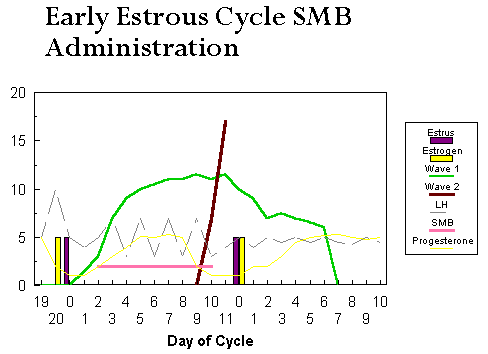
Early estrous cycle administration of SMB. Note
the second wave follicular growth and ovulation upon SMB removal.
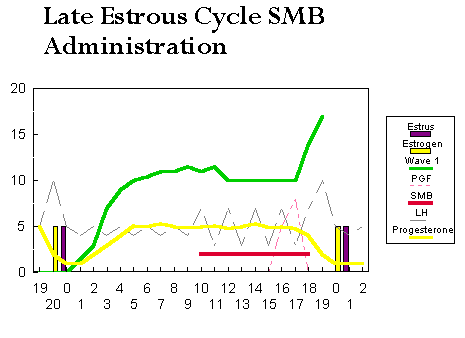
Late estrous cycle administration of SMB. Note the
first wave follicular ovulation of an aged oocyte upon SMB removal.
- This can be circumvented by providing higher
doses of progestagens which prevent LH release and therefore allow
'fresh', new follicular waves of follicles to arise. Combining a 14
MGA treatment with PGF 17 days after the MGA withdrawal provides a
hybrid system where good synchrony is achieved, but the low
fertility of MGA is avoided by having all the cows on days 11-16 of
the cycle for the PGF injection.
 Prostaglandins
vs Syncro-Mate B Prostaglandins
vs Syncro-Mate B
- In a study comparing PGF and SMB in beef cows,
conception rates were 65% for both groups, calving rates were 60%
and 57%, man hours invested were 57 and 44, and calving occurred
over 22 and 17 days for the PGF and SMB groups, respectively.
FAILURES
 Beef cows
Beef cows
- The biggest reason most estrus synchronization
methods fail in beef cows is that the cows are not actually cycling.
Nutritional anestrus is extremely common in beef cows. It is
imperative that the cows receive adequate prepartum nutrition to
enable them to resume cycling as soon as possible after parturition.
- It is also important not to try to breed the
cows before a substantial number has had adequate postpartum time to
resume cycling. In most cases the entire herd should be at least 60
days postpartum in order to expect estrus synchronization to work.
If the herd average is 60 days postpartum, then half the herd will
be less than 60 days postpartum and probably won't be cycling.
- Prostaglandins will definitely not work if the
cows are not cycling and have mature corpora lutea.
- In the case of SMB it has been shown that the
estradiol valerate will make ovariectomized cows show standing
estrus after treatment, so even anestrus cows will show estrus, but
fertility will obviously be low.
Will estrus synchronization work for the producer?
- As mentioned, the nutrition of the cows must be
adequate to ensure the cows are cycling. How can this be determined?
- If 5% of the herd is seen in heat daily, then
most of the cows are cycling. Palpation may help, but is certainly
not 100% accurate in determining cyclicity.
- Heat detection must also be good. Again, if 5%
of the cows are not seen in heat daily, then the cows are either not
cycling or heat detection is not adequate. At present, time breeding
will not give very good conception rates because the tightness of
estrus synchrony is not good enough.
- The AI and semen handling must be good. If
previous conception rates were not good, then the drugs use to
synchronize estrus will not improve conception rates. If the AI
technician is used to breeding 4 cows/day, can they breed 25 cows
consecutively?
- If a group of cows is to be synchronized then
handling facilities and manpower must be available to handle the
animals. If 25 cows are in estrus, the whole estrus synchronization
plan will fail if you cannot get the cows to a breeding chute or the
first cow through the chute destroys the facilities.
What can a producer expect for results if the
estrus synchronization system is correctly implemented on cycling cows?
- No better results than previous fertility
parameters such as services/conception, pregnancy rates, calving
interval and calving season duration should be expected. The
producer must decide if time (increased heat detection) or money
(increased drug) are going to be invested.
Dairy cows
- Since nutritional anestrus is usually not a
problem in dairy cows, heat detection inefficiency and a perception
of drug failure are the biggest hurdle for dairymen. The tightness
of estrual synchrony is not good enough to allow strict timed
breeding, therefore heat detection is still important. Having more
cows in heat during a limited heat detection period will aid the
dairyman. However, if heat detection is poor, the results of the
estrus synchronization program will be perceived as poor. A good
indication of heat detection efficiency on a dairy is the percentage
of cows diagnosed pregnant at pregnancy examination. At least 85% of
the cows presented for pregnancy examination should be pregnant. If
not, then at least 1 heat was missed by the dairyman to think the
cow did not return to estrus and was assumed pregnant.
- A perceived drug failure is to be expected
since only 13/21 should come into estrus and only 9/21 actually
respond to the PGF in a random cycling group of cows. The perception
by the dairyman may be that the program is not working very well
when it is actually working exactly as expected.
 Current Current

Click to see a PowerPoint
on the 'Synch' Systems

- A potentially exciting estrus synchronization
method has been investigated using a combination of GnRH and PGF.
The injection of GnRH causes all estrogen dominant follicles to
ovulate, recruits new follicles, and luteinizes 'old' follicles. On
day 7 a PGF injection is given. Since the follicles have been
luteinized and the follicular waves have been synchronized, all the
cows should come into estrus and ovulate at approximately the same
time. A second GnRH injection 48 hours after the PGF injection helps
ensure ovulation. If time breeding is desired, then the cows can be
bred 16 hours after the GnRH injection. Conception rates of 50% have
been reported in initial trials.
- Recent work has used half the dose of GnRH and
found conception rates to be good.
"Ovsynch" System - Prostaglandin Injection System
With GnRH
|
GnRH
injection
Day 1
|
|
PGF
injection
Day 7
|
|
2nd GnRH
48 hours after PGF
|
|
Day of
Cycle Day 0
|
|
“Stage”
of Cycle Day 7
|
|
Breed 16
hours after GnRH
|
|
0
|
Ovulates
Follicle
|
“Luteal”
|
Responds
to injection and come into estrus, Breed
|
Breed‑16
hr
|
|
1 -15
|
Causes
luteinization and recruits new follicles.
|
“Luteal”
|
|
|
|
16 -20
|
Ovulates
Follicle
|
7
|
|
|
 "Ovsynch"
variation using second estradiol benzoate instead of second dose of GnRH "Ovsynch"
variation using second estradiol benzoate instead of second dose of GnRH
Fernandes,P; Teixeira,AB; Crocci,AJ; Barros,CM (2001): Timed
artificial insemination in beef cattle using GnRH agonist, PGF2alpha and
estradiol benzoate (EB). Theriogenology 55(7, 15 Apr), 1521-1532.
-
Cows
treated (Day 0), at random stages of the estrous cycle, with 8 mug of
buserelin acetate (GnRH agonist)
-
Seven
days later (D 7) all animals were treated with 25 mg of dinoprost
trometamine (PGF2 alpha)
-
The
cows from received one injection of estradiol benzoate on
day 8.
-
AI
was performed at 30 to 34 h after the estradiol benzoate injection.
-
Pregnancy
rate was 43.3% for timed AI (compared to 47.7% obtained after regular
"Ovsynch" GnRH.
Different
Estrous synchronization methods and their names
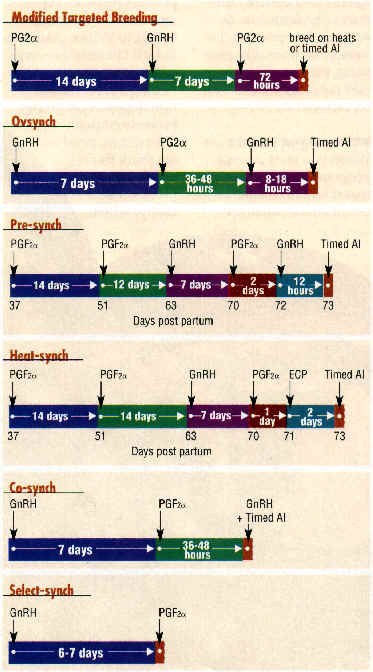
Kitchen-sink 
Synchronization
Progams from CRI
Horizons (Genex)
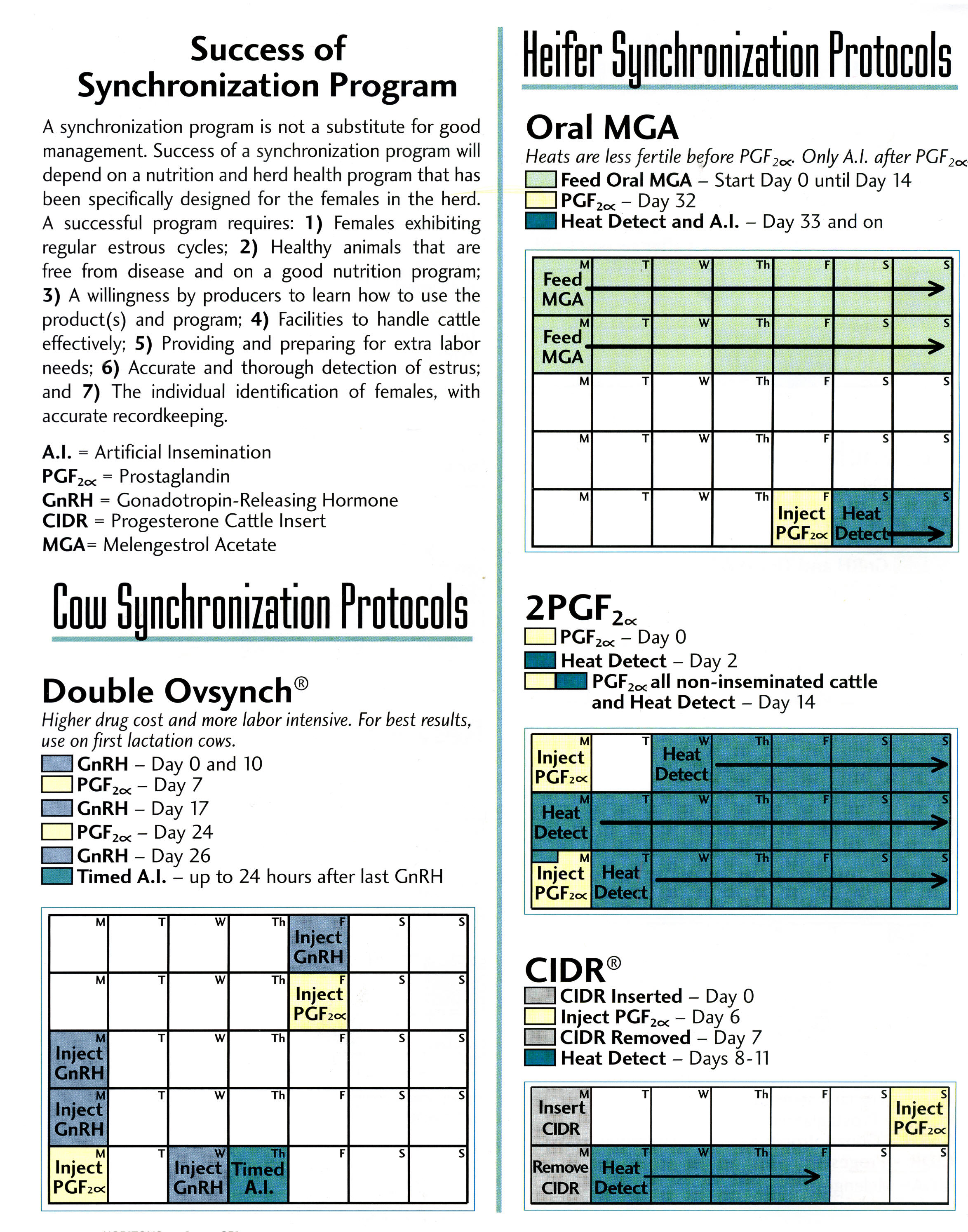
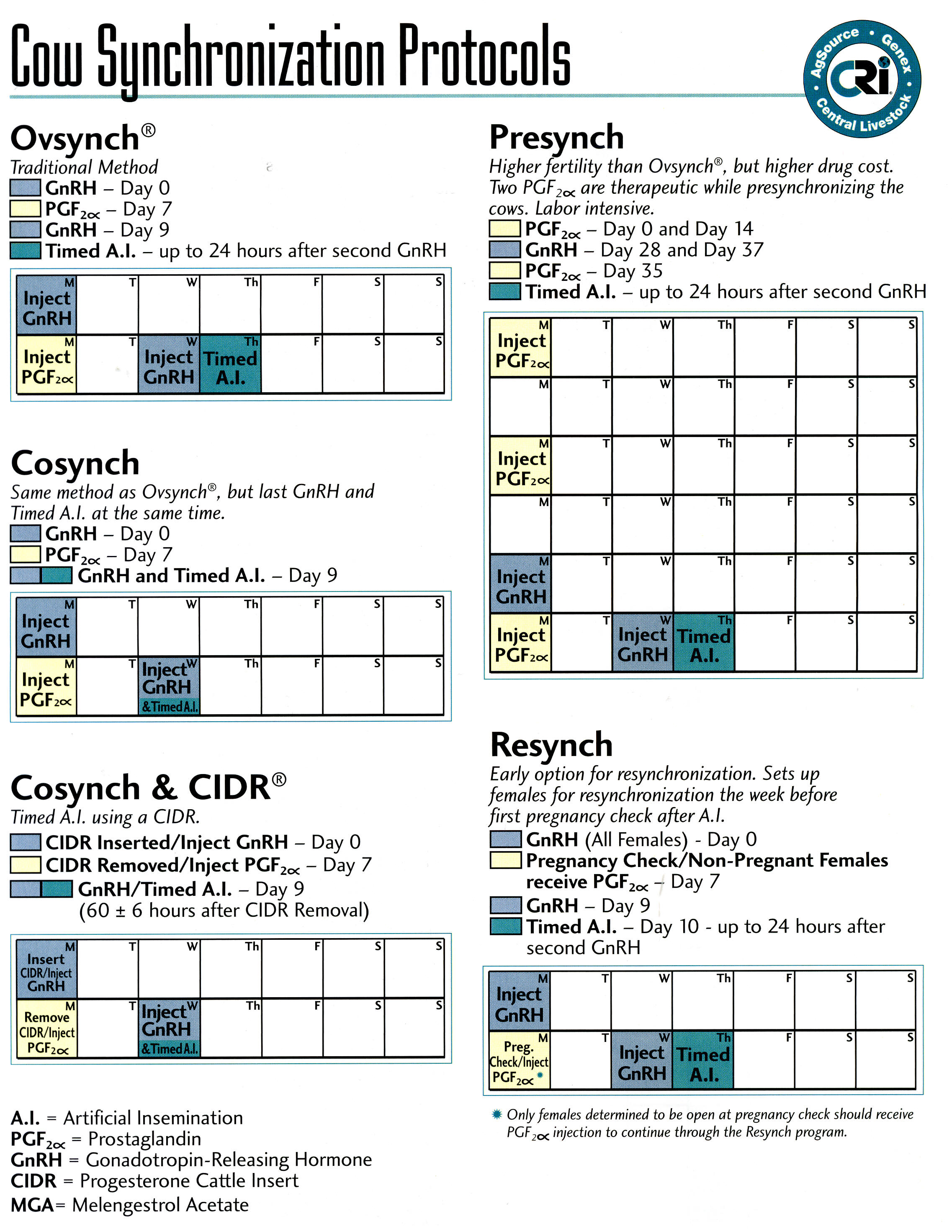  Double
Synch Double
Synch
Theriogenology
73 (2010) p 568-576
|
Day O |
Day 2 |
Day 9 |
Day 11 |
16-20 hr post GnRH |
|
PGF |
GnRH |
PGF |
GnRH |
Timed AI |
·
Anestrus cows included
o
72% PR (Ovsynch – 23%)
o
Too good to be true?
o
PGF enhances pituitary LH?
·
Cycling cows
o
76% vs 46% for Ovsynch
 CIDR
(Controlled intravaginal drug releaser) CIDR
(Controlled intravaginal drug releaser)
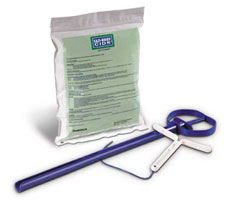
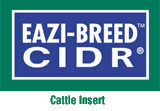
Click above to link to Pharmacia page on CIDR
-
How the EAZI-BREED
CIDR Insert Works
The EAZI-BREED™ CIDR® Cattle Insert is a T-shaped device
that's impregnated with progesterone. Placed in the animal's vagina, the
EAZI-BREED CIDR Insert continually releases progesterone. Removing the
insert and the corresponding injection of LUTALYSE®
Sterile Solution (dinoprost tromethamine) causes a drop in progesterone,
which triggers estrus and ovulation.
- When?
- By continuously releasing progesterone, the EAZI-BREED
CIDR Insert allows you to start breeding programs at any stage of the
estrous cycle. This provides a new solution for synchronization.
| Day 0 |
Day 6 |
Day 7 |
Day 8 - 11 |
|
 |
Administer the EAZI-BREED™
CIDR® Cattle Insert |
 |
Inject 5 mL
LUTALYSE®
Sterile Solution
(dinoprost
tromethamine) |
 |
Remove the EAZI-BREED™
CIDR® Cattle Insert |
 |
Heat detect and breed on detected estrus |
- Administration
Insertion and removal of the EAZI-BREED™ CIDR® Cattle
Insert quickly can become a standard part of any herd's breeding
routine. View this video
clip to see how to administer the EAZI-BREED CIDR Insert.
For best results, follow these simple steps:
- Wear protective gloves whenever handling the EAZI-BREED
CIDR Insert.
- Prepare a container of clean water with
disinfectant solution to wash the applicator between uses.
- Fit the body of the insert into the applicator with
the tail along the slot. The two wings will be pushed together,
protruding about one inch above the top of the applicator.
- Apply a generous amount of lubricant to the tip of
the insert.
- Shift the animal's tail to one side, and clean the
vulva.
- Make sure the tail of the EAZI-BREED CIDR Insert is
on the underside of the applicator, curling down, to ensure that the
tail will be hidden from curious penmates.
- Open the lips of the vulva and insert the
applicator at a slight upward angle, moving forward over the pelvic
bone until it meets resistance.
- Dispense the insert from the applicator by
depressing the plunger, then slowly withdrawing the applicator body.
- To prevent removal by curious penmates, you may
want to clip the tail of the insert so that 2.5 inches protrude from
the vulva.
- To withdraw the insert, simply give the tail a
gentle but firm pull to release the insert.
- Dispose of used inserts in a sealed, plastic
container in accordance with applicable local, state and federal
regulations.
-
Table 1 shows that cows bred following
use of EAZI-BREED CIDR Inserts had a significantly higher percentage of
synchrony than the other two groups, for both cycling and non-cycling
cows. This improved synchrony led to greater pregnancy rates.
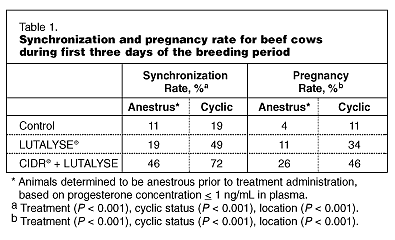
Source: Lucy, et. al., Journal of Animal Science,
2001. 79:982-995.
- What is the expected pregnancy rate with a
controlled breeding program using EAZI-BREED™ CIDR® Cattle
Inserts? How does it compare to other programs?
Trials conducted with dairy heifers, beef cows and beef heifers to
secure FDA clearance of the EAZI-BREED™ CIDR® Cattle
Insert in the United States showed the following pregnancy rates from
three days of breeding following initiation of the program:*
- No controlled breeding program: 4 to 11 percent
- Controlled breeding with a single injection of LUTALYSE®
Sterile Solution (dinoprost tromethamine): 6 to 37 percent
- Controlled breeding with EAZI-BREED CIDR Inserts plus LUTALYSE:
26 to 49 percent
*Results may vary.
Other
Products that are used in Europe, but not approved in
the United States are progesterone releasing intravaginal device (PRID)
and controlled internal drug releaser (CIDR).
Results of clinical trials
(Day SFT Proceedings 2003) Pregnancy
rates in %
| Method |
Heifers |
Cows-Beef |
Note |
| |
Conception Rate |
Pregnancy Rate* |
CR |
*PR rate based on cycling |
| Select Synch |
64 |
- |
|
|
| Co-Synch |
39 |
39 |
|
|
| PGF |
63 |
- |
|
|
| MGA + PGF |
67 |
57 |
|
|
| CIDR + Co-Synch |
66 |
66 |
|
|
| CIDR + PGF |
60 |
39 |
|
|
| CIDR + Estradiol |
60 |
60 |
|
|
| PGF + GnRH |
|
|
75 (4.4) |
< 10 mm follicles (more EED) |
| |
|
100 |
Spontaneous |
| |
|
57 |
> 13 |
| |
|
8 |
ET to < 10 mm |
| |
|
67 |
ET to > 10 |
SUMMARY
- Although the ideal estrus synchronization
program is not available, strides are being made toward attaining
the goal. Presently, producers must maintain good management systems
and choose an estrus synchronization method that best fits their
management and budget situations.
|






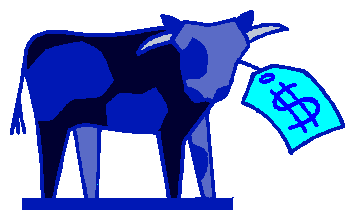 Bovine
Index
Bovine
Index














